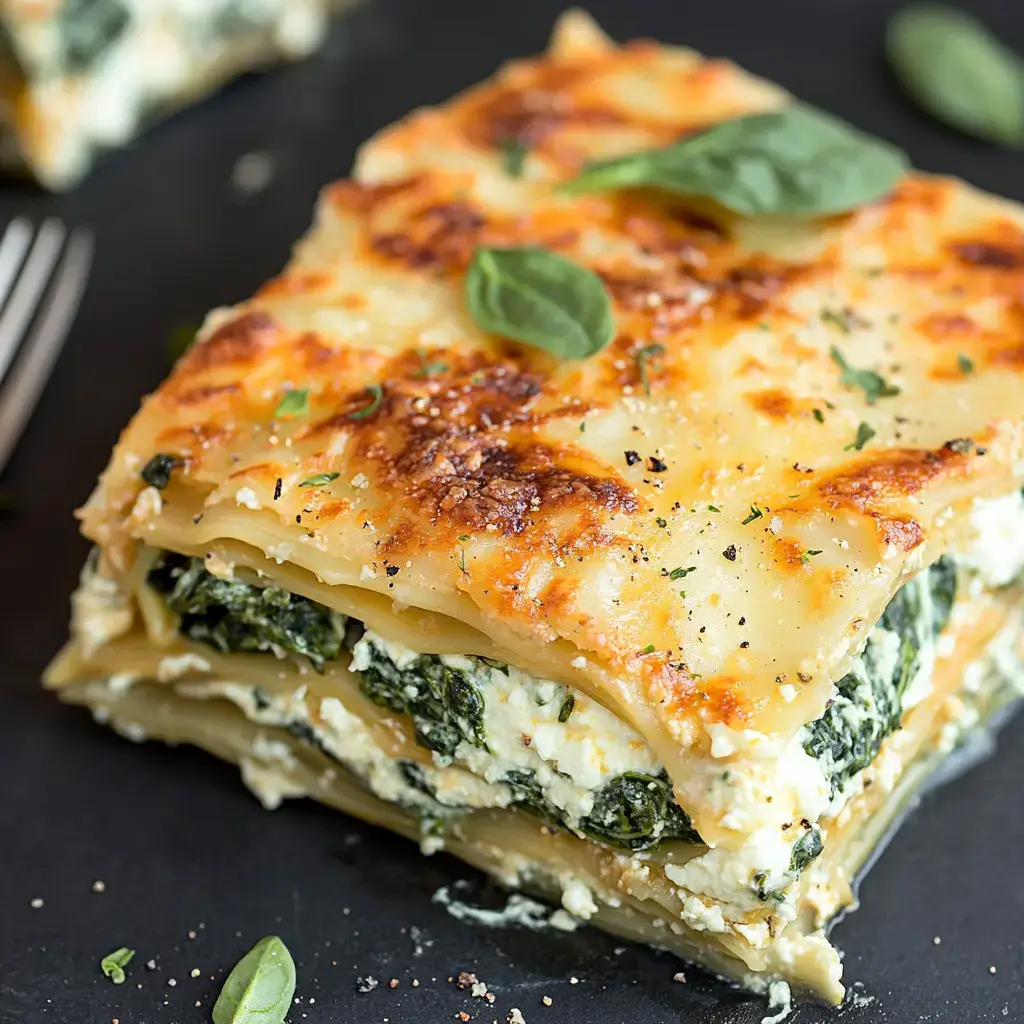Lasagna is a classic Italian dish that has been enjoyed by families around the world for generations. The comforting layers of pasta, cheese, and sauce create a meal that is both satisfying and rich in flavor. For those who want to enjoy this traditional dish without the meat, a Vegetarian Lasagna with Spinach and Ricotta is a perfect alternative that doesn’t compromise on taste or texture. This recipe is not only easy to make but also offers a nutritious option for those seeking a healthier lifestyle.
Ingredients You’ll Need
Creating this delectable Vegetarian Lasagna with Spinach and Ricotta requires a selection of fresh and nutritious ingredients. Here’s what you’ll need:
- 9 lasagna noodles
- 2 cups ricotta cheese
- 3 cups fresh spinach
- 2 cups marinara sauce
- 1 cup shredded mozzarella cheese
- 1/2 cup grated Parmesan cheese
- 1 egg (or egg substitute)
- 1 tsp dried Italian herbs
- Salt and pepper to taste
These ingredients come together to create a dish that is full of flavor and packed with nutrients.
Step-by-Step Instructions
Making Vegetarian Lasagna with Spinach and Ricotta is a straightforward process that involves layering the ingredients and baking them to perfection. Follow these easy steps:
- Preheat Your Oven: Set your oven to 375°F (190°C) to ensure it’s ready for baking the lasagna.
- Prepare the Noodles: Cook the lasagna noodles according to the package directions. Once cooked, drain them and set them aside.
- Mix the Filling: In a large bowl, combine the ricotta cheese, fresh spinach, egg (or egg substitute), Italian herbs, salt, and pepper. Mix until all ingredients are well incorporated.
- Layer the Lasagna:
- Spread a generous layer of marinara sauce on the bottom of a baking dish.
- Place 3 lasagna noodles over the sauce.
- Add half of the ricotta and spinach mixture over the noodles.
- Repeat the layering process with another layer of marinara sauce, noodles, and the remaining ricotta mixture.
- Top with the last layer of noodles and the remaining marinara sauce.
- Add the Cheeses: Sprinkle the shredded mozzarella and grated Parmesan cheese evenly over the top layer.
- Bake: Cover the baking dish with foil and bake for 25 minutes. Then, remove the foil and bake for an additional 15 minutes, or until the cheese is bubbly and golden brown.
- Cool and Serve: Let the lasagna cool for a few minutes before slicing and serving.
Nutrition Facts
Understanding the nutritional content of your meals is important for maintaining a balanced diet. Here’s a breakdown of the nutrition facts for this Vegetarian Lasagna with Spinach and Ricotta per serving (makes 6 servings):
- Calories: 300
- Protein: 18g
- Carbohydrates: 30g
- Fat: 12g
- Fiber: 3g
This dish offers a good balance of protein, carbs, and fats, making it a wholesome meal choice.
How to Serve Your Vegetarian Lasagna
Lasagna is a versatile dish that not only satisfies the palate but also adapts beautifully to various dining scenarios. Whether you’re hosting a cozy family dinner, a festive gathering, or a casual lunch with friends, the way you serve your vegetarian lasagna can elevate the overall dining experience. Below are some comprehensive serving suggestions that enhance the enjoyment of your lasagna while catering to different occasions.
1. With a Side Salad
A fresh green salad is an excellent accompaniment to vegetarian lasagna, providing a contrasting texture and lightness that balances the richness of the dish. Opt for a variety of greens such as arugula, spinach, or mixed baby greens. You may also consider adding colorful vegetables like cherry tomatoes, cucumbers, and bell peppers for additional crunch and flavor.
Dressing Options:
- A light vinaigrette made with olive oil, balsamic vinegar, and a hint of Dijon mustard can brighten the salad and enhance its freshness.
- For a creamier option, consider a Caesar dressing or a tahini-based dressing that adds a nutty flavor.
Add Some Protein: If you want to make the salad heartier, toss in some chickpeas, roasted sunflower seeds, or crumbled feta cheese. This will not only add protein but also additional layers of flavor.
2. Garlic Bread
Warm garlic bread is a classic side that perfectly complements a serving of lasagna, allowing diners to soak up the savory marinara sauce. You can easily prepare garlic bread by spreading a mixture of softened butter, minced garlic, and fresh parsley over slices of baguette or ciabatta. Bake until golden and crispy for a delightful crunch.
Variations:
- For a twist, try using herbed butter or adding a sprinkle of grated Parmesan cheese before baking.
- You can also make garlic knots by tying strips of pizza dough into knots, coating them with the garlic mixture, and baking until golden.
3. Wine Pairing
Pairing your vegetarian lasagna with the right wine can enhance the meal significantly. A glass of red wine, such as Chianti or Merlot, is particularly well-suited to the robust flavors of the dish. These wines offer fruity notes that complement the savory elements of the lasagna, from the marinara sauce to the cheesy layers.
Alternative Options:
- If you prefer white wine, a Sauvignon Blanc or a lightly oaked Chardonnay can provide a refreshing contrast while still holding up against the lasagna’s richness.
- For a non-alcoholic option, consider serving sparkling water with lemon or a flavorful herbal iced tea that can cleanse the palate.
4. For a Crowd
One of the great advantages of vegetarian lasagna is its ability to be prepared in large quantities, making it an ideal choice for family gatherings or dinner parties. This recipe can easily be doubled or even tripled, allowing you to serve a hearty meal to a larger group without sacrificing flavor.
Serving Tips:
- Prepare the lasagna a day in advance, allowing the flavors to meld overnight. When you’re ready to serve, simply bake it until bubbly and golden.
- For easy serving, cut the lasagna into squares or rectangles and use a spatula to serve each piece. This not only makes for neat portions but also allows guests to take as much as they desire.
Presentation:
- Serve the lasagna on a large, rustic platter or in a beautiful casserole dish to create an inviting centerpiece on your dining table.
- Garnish with fresh basil leaves or a sprinkle of grated Parmesan cheese just before serving for a pop of color and added flavor.
5. Additional Side Dishes
To create a more complete meal, consider adding complementary side dishes.
Roasted Vegetables: A medley of roasted seasonal vegetables, such as zucchini, bell peppers, and eggplant, can echo the flavors in your lasagna and provide additional nutrients.
Antipasto Platter: An antipasto platter featuring olives, marinated artichokes, roasted red peppers, and a selection of cheeses can serve as a delightful starter before the main course.
Dessert: Conclude the meal with a light dessert, such as a sorbet or panna cotta, to cleanse the palate after the hearty lasagna.
By thoughtfully considering how to serve your vegetarian lasagna, you can create a memorable dining experience that delights all the senses. From fresh salads to wine pairings and thoughtful presentation, each element contributes to a meal that is both satisfying and enjoyable.
Additional Tips for the Perfect Lasagna
To make your Vegetarian Lasagna with Spinach and Ricotta even more delightful, consider these additional tips:
1. Use Fresh Ingredients
Using fresh ingredients can significantly elevate the taste and overall quality of your lasagna. Fresh spinach, for example, has a vibrant flavor and a tender texture that dried or frozen spinach simply cannot replicate. Look for bright green leaves that are free from wilting or yellowing. If possible, wash and dry them just before use to maintain their freshness.
In addition to fresh spinach, the quality of your marinara sauce plays a pivotal role in the flavor profile of your lasagna. Choosing a high-quality, preferably homemade sauce can add depth and richness that store-bought varieties often lack. If you’re short on time, select a marinara made with organic ingredients, without preservatives or excess sugars. You can also enhance store-bought marinara by sautéing onions and garlic before adding the sauce, or by simmering it with fresh herbs like basil and oregano for extra flavor.
2. Make Ahead
One of the best tips for preparing lasagna is to make it ahead of time. Assembling your lasagna the day before allows all the flavors to meld together beautifully, leading to a richer and more developed taste when baked. After layering your ingredients, cover the assembled dish tightly with plastic wrap or aluminum foil and refrigerate it overnight. When you’re ready to serve, simply preheat your oven and bake it directly from the fridge. Just be aware that you may need to add a few extra minutes to the baking time since it will be starting cold.
If you’re feeling adventurous, consider freezing the lasagna instead. After assembling it, wrap it tightly, then freeze for up to three months. When you’re ready to enjoy your lasagna, it can be baked directly from frozen (just add additional cooking time) or thawed in the refrigerator overnight before baking.
3. Customize the Recipe
Vegetarian lasagna is incredibly versatile, allowing you to customize it to suit your tastes and dietary preferences. While spinach and ricotta are a classic combination, consider incorporating other vegetables to enhance both the texture and flavor profile of your dish.
Mushrooms add a hearty, umami flavor and a chewy texture. Sauté them first to release their moisture and intensify their flavor. Zucchini, when sliced thinly, can introduce a fresh and slightly sweet element, while bell peppers contribute a crisp, vibrant flavor. Roasted eggplant or butternut squash can also serve as great additions, offering a creamy texture and subtle sweetness.
Don’t forget to season your vegetables as you cook them! A sprinkle of salt, pepper, and a dash of red pepper flakes can elevate their taste. Additionally, adding fresh herbs like basil, thyme, or parsley can provide a burst of freshness that complements the richness of the cheese and sauce.
4. Egg Substitute
For those following a vegan diet or with egg allergies, it’s essential to have suitable substitutes to achieve the creamy texture typically provided by eggs in ricotta. A popular alternative is a flaxseed egg, which is made by mixing one tablespoon of ground flaxseed with three tablespoons of water. Let the mixture sit for about five minutes until it becomes gel-like, then incorporate it into your ricotta mixture.
Alternatively, consider using silken tofu blended until smooth, which can mimic the texture of ricotta quite well. If you prefer a more traditional flavor, nutritional yeast can be added for a cheesy taste without the use of dairy. There are also commercial egg replacers available that can be used according to package instructions. Each of these substitutes will help bind your ingredients while keeping your lasagna vegan-friendly.
By incorporating these additional tips, you can take your Vegetarian Lasagna with Spinach and Ricotta to the next level, ensuring a deliciously satisfying dish that everyone will enjoy!
FAQs About Vegetarian Lasagna
Q1: Can I use frozen spinach instead of fresh?
A1: Yes, you can use frozen spinach. Just make sure to thaw and drain it well before mixing it with the ricotta.
Q2: Can I freeze this lasagna?
A2: Absolutely! You can freeze the lasagna either baked or unbaked. Ensure it’s tightly wrapped to prevent freezer burn.
Q3: What can I use instead of ricotta cheese?
A3: Cottage cheese or a vegan ricotta substitute can be used if you’re looking for a different texture or a dairy-free option.
Q4: How can I make this recipe gluten-free?
A4: Simply use gluten-free lasagna noodles to accommodate dietary restrictions.
Q5: Can I add other cheeses?
A5: Certainly! Feel free to experiment with other cheeses like provolone or fontina for a unique flavor.
Conclusion
Vegetarian Lasagna with Spinach and Ricotta is a delightful and wholesome dish that brings the flavors of Italy into your kitchen without the meat. It’s perfect for vegetarians and anyone looking to enjoy a healthier version of a classic favorite. With its layers of creamy ricotta, fresh spinach, and savory marinara sauce, this lasagna promises to be a hit at your dinner table. Whether you’re serving it to family, friends, or enjoying it solo, this dish is sure to satisfy your cravings. Give this recipe a try, and savor the deliciousness of a homemade vegetarian lasagna!
Print
Vegetarian Lasagna with Spinach and Ricotta
Ingredients
Creating this delectable Vegetarian Lasagna with Spinach and Ricotta requires a selection of fresh and nutritious ingredients. Here’s what you’ll need:
- 9 lasagna noodles
- 2 cups ricotta cheese
- 3 cups fresh spinach
- 2 cups marinara sauce
- 1 cup shredded mozzarella cheese
- 1/2 cup grated Parmesan cheese
- 1 egg (or egg substitute)
- 1 tsp dried Italian herbs
- Salt and pepper to taste
Instructions
Making Vegetarian Lasagna with Spinach and Ricotta is a straightforward process that involves layering the ingredients and baking them to perfection. Follow these easy steps:
- Preheat Your Oven: Set your oven to 375°F (190°C) to ensure it’s ready for baking the lasagna.
- Prepare the Noodles: Cook the lasagna noodles according to the package directions. Once cooked, drain them and set them aside.
- Mix the Filling: In a large bowl, combine the ricotta cheese, fresh spinach, egg (or egg substitute), Italian herbs, salt, and pepper. Mix until all ingredients are well incorporated.
- Layer the Lasagna:
- Spread a generous layer of marinara sauce on the bottom of a baking dish.
- Place 3 lasagna noodles over the sauce.
- Add half of the ricotta and spinach mixture over the noodles.
- Repeat the layering process with another layer of marinara sauce, noodles, and the remaining ricotta mixture.
- Top with the last layer of noodles and the remaining marinara sauce.
- Add the Cheeses: Sprinkle the shredded mozzarella and grated Parmesan cheese evenly over the top layer.
- Bake: Cover the baking dish with foil and bake for 25 minutes. Then, remove the foil and bake for an additional 15 minutes, or until the cheese is bubbly and golden brown.
- Cool and Serve: Let the lasagna cool for a few minutes before slicing and serving.
Nutrition
- Serving Size: one normal portion
- Calories: 300
- Fat: 12g
- Carbohydrates: 30g
- Fiber: 3g
- Protein: 18g




